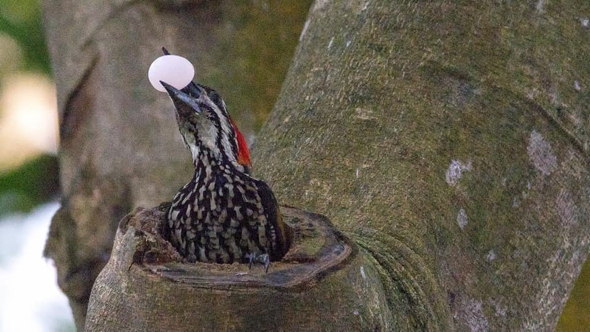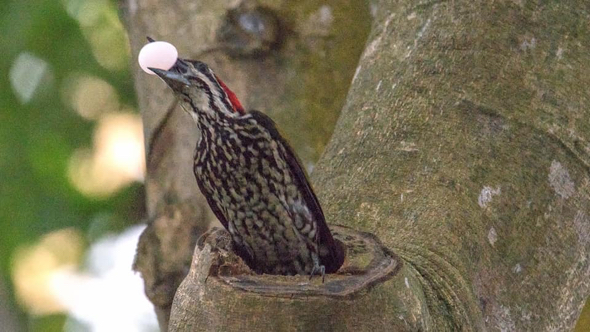Jon Chia’s two images of a Common Flameback (Dinopium javanense) leaving a nest cavity with a white egg between its mandibles pose a question of exactly what the flameback was doing (above, below). Was it shifting nest as it found this cavity unsuitable for one reason or another? Was it cleaning the nest and dumping the egg found inside so that it can make use of the cavity? After all, nesting cavities are generally in high demand as not many birds are capable of chiselling cavities from old and rotting trees.
The paper by Koenig & Walters (2014) on the nesting behaviour of the Acorn Woodpecker (Melanerpes formicivorus) may provide a possible answer of what was going on. This woodpecker is a neotropical bird found along the west coast of North America, right down to Central America and the northern part of South America.
The Acorn Woodpecker indulges in cooperative breeding, where non-breeding birds assist the nesting pair to take care of the nestlings in the nest (Erritzoe et al, 2007). These helpers are often siblings from the last brood.
Again, according to Koenig & Walters (2014), Acorn Woodpeckers live in family groups of up to 15 individuals made up of both sexes. The males compete for mating within the group while the females lay eggs communally in the same nest. These may be fertile eggs or runt eggs. The latter are smaller in size and contain no yoke. These runt eggs are laid just before the female lays normal eggs.
Once a co-breeding female Acorn Woodpecker is ready to lay her eggs, she will destroy the runt eggs. There runt eggs are believed (but not proven) to provide much needed nutrition to the laying female. However, whether these eggs are destroyed inside the nest or removed to be disposed of elsewhere is not mentioned.
We have not been able to locate any information on whether the Common Flameback indulges in cooperative breeding… and that it behaves like the Acorn Woodpeckr. We can only speculate that it is possible that this Common Flameback may be removing a foreign egg for disposal.
Comments are welcome.
Jon Chia & YC Wee
Singapore
11th August 2018
References:
1. Erritzoe, J., K. Kampp, K. Winker & C. B. Frith, 2007. The ornithologist’s dictionary. Lynx Edicions, Barcelona. 290 pp.
2. Koenig, W. D. & E. L. Walters, 2014. What we don’t know, and what needs to be known, about the cooperatively breeding Acorn Woodpecker Melanerpes formicivorus. Acta Ornithologica 49 (2);221-232 PDF.
This post is a cooperative effort between Birds, Insects N Creatures Of Asia and BESG to bring the study of birds and their behaviour through photography and videography to a wider audience.











3 Responses
Excellent documentation & discussion.
Thanks Amar.
Hi, Jon and YC,
Excellent observations and record .
Do you know the name of the tree ?
Thanks .. EK